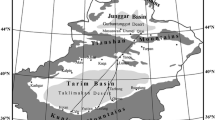Abstract
Serious desertification caused by human activity and climate change, in addition to water loss and soil erosion related to arsenic sandstone in the Mu Us Sandy Land, lead to severe scarcity of soil and water resources, which causes worse local agricultural conditions accordingly. Many physical properties of arsenic sandstone is complementary with that of sand, arsenic sandstone is therefore supposed to be blended to enhance water productivity and arability of sandy land. Container experiments are carried out to study the enhancement of water holding capacity of the mixture, the blending ratio of arsenic sandstone and sand, and the proper size of the arsenic sandstone particles, respectively. The results of the experiments show that particle size of 4 cm with a ratio of 1:2 between arsenic sandstone and sand are the proper parameters on blending. Both water content and fertility increase after blending. Water use efficiency in the mixture is 2.7 times higher than that in sand by the water release curves from experiments. Therefore, a new sand control and development model, including arsenic sandstone blending with sand, efficient water irrigation management and reasonable farming system, is put forward to control and develop sandy land so that water-saving agriculture could be developed. Demonstration of potato planting about 153.1 ha in area in the Mu Us Sandy Land in China indicates that water consumption is 3018 m3/ha in the whole growth period. It means that about 61% of irrigation water can be saved compared with water use in coarse sand without treatment. Recycle economic mode and positive feedback of sand resource-crop planting-soil resource are constructed, which changes sand into arable soil and make it possible to develop water-saving agriculture on it. The proposed model will be helpful for soil-water resources utilization and management in the Mu Us Sandy Land.
Similar content being viewed by others
References
Andry H, Yamamoto T, Irie T, 2009. Water retention, hydraulic conductivity of hydrophilic polymers in sandy soil as affected by temperature and water quality. Journal of Hydrology, 373(1–2): 177–183. doi: 10.1016/j.jhydrol.2009.04.020
Djajadi, Lynette K A, Christoph H, 2012. Synergistic impacts of clay and organic matter on structural and biological properties of a sandy soil. Geoderma, 183–184: 19–24. doi: 10.1016/j.geoderma.2012.03.012
Dong Wen, Zhao Jingbo, 2006. The formation and harness of Mu Us Desert. Journal of Guizhou Normal University (Natural Sciences), 24(4): 42–46. (in Chinese)
Ismail Saleh M, Ozawa K, 2007. Improvement of crop yield, soil moisture distribution and water use efficiency in sandy soils by clay application. Applied Clay Science, 37(1–2): 81–89. doi: 10.1016/j.clay.2006.12.005
Liu Jianqiu, 2010. The causes and countermeasures of desertification in Mu Us Sandland. Inner Mongolia Forestry Investigatione and Design, 337(6): 18–21. (in Chinese)
Ma Yunyan, Zhao Hongyan, Yan Xiao et al., 2009. Comparing of physic and chemical property of aeolian sandy soil before and after improvement. Journal of Jilin Agricultural Sciences, 34(6): 40–44. (in Chinese)
Man Duoqing, Xu Xianying, Wu Chunrong et al., 2003. Research on seedling cultivation of pinus sylvestris at film-bottomed sand land in arid desert area. Journal of Soil and Water Con servation, 17(3): 170–173. (in Chinese)
Huang Y Z, Wang N A, He T H et al., 2009. Historical desertification of the Mu Us Desert, northern China: A multidisciplinary study. Geomorphology, 110(3–4): 108–117. doi: 10.1016/j.geomorph.2009.03.020
Dai Z G, 2010. Intensive agropastoralism: Dryland degradation, the Grain-to-Green Program and islands of sustainability in the Mu Us Sandy Land of China. Agriculture, Ecosystems and Environment, 138(3–4): 249–256. doi: 10.1016/j.agee.2010.05.006
Ould Ahmed B A, Yamamoto T, Rasiah V, 2007. The impact of saline water irrigation management options in a dune sand on available soil water and its salinity. Agricultural Water Management, 88(1–3): 63–72. doi: 10.1016/j.agwat.2006.10.001
Portnov B A, Safriel U N, 2004. Combating desertification in the Negev: Dryland agriculture vs. dryland urbanization. Journal of Arid Environments, 56(4): 659–680. doi: 10.1016/S0140-1963(03)00087-9
Wang Rende, Wu Xiaoxu, 2009. New pattern to control Mu Us Sandland. Research of Soil and Water Conservation, 16(5): 176–180. (in Chinese)
Wang Zhi, Peng Ruyan, Wang Lei et al., 2006. Studies on soil properties of aeolian sandy land improvement and utilization in South edge of Mu Us Desert. Journal of Soil and Water Conservation, 20(2): 14–21. (in Chinese)
Wu Chaobao, Ren Gang, Li Jinyu, 2009. Experimental study on water requirements and irrigation schedule of potato. Journal of Irrigation and Drainage, 28(3): 93–95. (in Chinese)
Zhao Xueyong, Zhang Chunmin, Zuo Xiao’an et al., 2009. CChallenge to the desertification reversion in Horqin Sandy Land. Chinese Journal of Applied Ecology, 220(7): 1559–1564. (in Chinese)
Author information
Authors and Affiliations
Corresponding author
Additional information
Foundation item: Under the auspices of National Natural Science Foundation of China (No. 51079120), Education Department Research Program of Shaanxi Province (No. 12JK0481), Water Conservancy Science and Technology Plan of Shaanxi Province (No. 2012-07)
Rights and permissions
About this article
Cite this article
Wang, N., Xie, J. & Han, J. A sand control and development model in sandy land based on mixed experiments of arsenic sandstone and sand: A case study in Mu Us Sandy Land in China. Chin. Geogr. Sci. 23, 700–707 (2013). https://doi.org/10.1007/s11769-013-0640-7
Received:
Accepted:
Published:
Issue Date:
DOI: https://doi.org/10.1007/s11769-013-0640-7




